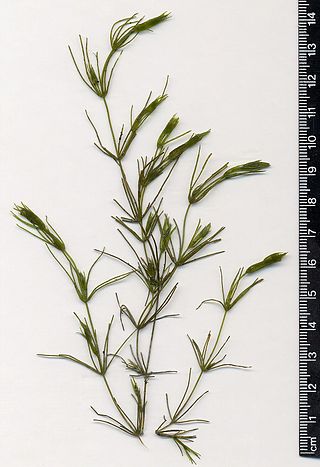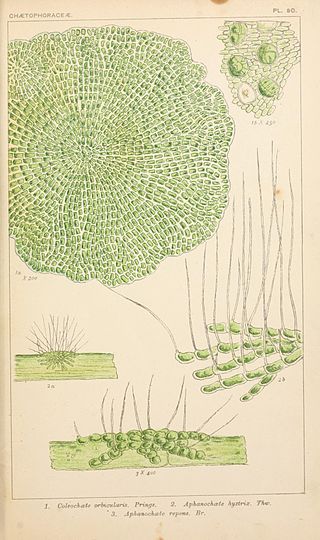
The Chlorophyceae are one of the classes of green algae, distinguished mainly on the basis of ultrastructural morphology. They are usually green due to the dominance of pigments chlorophyll a and chlorophyll b. The chloroplast may be discoid, plate-like, reticulate, cup-shaped, spiral- or ribbon-shaped in different species. Most of the members have one or more storage bodies called pyrenoids located in the chloroplast. Pyrenoids contain protein besides starch. Some green algae may store food in the form of oil droplets. They usually have a cell wall made up of an inner layer of cellulose and outer layer of pectose.

Chlorophyta is a taxon of green algae informally called chlorophytes. The name is used in two very different senses, so care is needed to determine the use by a particular author. In older classification systems, it is a highly paraphyletic group of all the green algae within the green plants (Viridiplantae) and thus includes about 7,000 species of mostly aquatic photosynthetic eukaryotic organisms. In newer classifications, it is the sister clade of the streptophytes/charophytes. The clade Streptophyta consists of the Charophyta in which the Embryophyta emerged. In this latter sense the Chlorophyta includes only about 4,300 species. About 90% of all known species live in freshwater. Like the land plants, green algae contain chlorophyll a and chlorophyll b and store food as starch in their plastids.

Volvox is a polyphyletic genus of chlorophyte green algae in the family Volvocaceae. Volvox species form spherical colonies of up to 50,000 cells, and for this reason they are sometimes called globe algae. They live in a variety of freshwater habitats, and were first reported by Antonie van Leeuwenhoek in 1700. Volvox diverged from unicellular ancestors approximately 200 million years ago.

The Zygnematales, also called the Conjugatales, are an order of green algae, comprising several thousand different species in two families. The larger family Zygnemataceae, with well-known genera such as Zygnema and Spirogyra, includes members that grow as unbranched filaments, which grow longer through normal cell division. This group includes the desmids. Most members of both families live in freshwater, and form an important component of the algal scum that grows on or near plants and rocks.

The glaucophytes, also known as glaucocystophytes or glaucocystids, are a small group of unicellular algae found in freshwater and moist terrestrial environments, less common today than they were during the Proterozoic. The stated number of species in the group varies from about 14 to 26. Together with the red algae (Rhodophyta) and the green algae plus land plants, they form the Archaeplastida.

The embryophytes are a clade of plants, also known as Embryophyta or land plants. They are the most familiar group of photoautotrophs that make up the vegetation on Earth's dry lands and wetlands. Embryophytes have a common ancestor with green algae, having emerged within the Phragmoplastophyta clade of freshwater charophyte green algae as a sister taxon of Charophyceae, Coleochaetophyceae and Zygnematophyceae. Embryophytes consist of the bryophytes and the polysporangiophytes. Living embryophytes include hornworts, liverworts, mosses, lycophytes, ferns, gymnosperms and angiosperms. Embryophytes have diplobiontic life cycles.

The green algae are a group of chlorophyll-containing autotrophic eukaryotes consisting of the phylum Prasinodermophyta and its unnamed sister group that contains the Chlorophyta and Charophyta/Streptophyta. The land plants (Embryophytes) have emerged deep in the Charophyte alga as a sister of the Zygnematophyceae. Since the realization that the Embryophytes emerged within the green algae, some authors are starting to include them. The completed clade that includes both green algae and embryophytes is monophyletic and is referred to as the clade Viridiplantae and as the kingdom Plantae. The green algae include unicellular and colonial flagellates, most with two flagella per cell, as well as various colonial, coccoid (spherical), and filamentous forms, and macroscopic, multicellular seaweeds. There are about 22,000 species of green algae, many of which live most of their lives as single cells, while other species form coenobia (colonies), long filaments, or highly differentiated macroscopic seaweeds.

Streptophyta, informally the streptophytes, is a clade of plants. The composition of the clade varies considerably between authors, but the definition employed here includes land plants and all green algae except the Chlorophyta and the more basal Prasinodermophyta.

Charophyta is a group of freshwater green algae, called charophytes, sometimes treated as a division, yet also as a superdivision or an unranked clade. The terrestrial plants, the Embryophyta emerged deep within Charophyta, possibly from terrestrial unicellular charophytes, with the class Zygnematophyceae as a sister group.

Characeae is a family of freshwater green algae in the order Charales, commonly known as stoneworts. They are also known as brittleworts or skunkweed, from the fragility of their lime-encrusted stems, and from the foul odor these produce when stepped on.

Oogamy is a form of anisogamy where the gametes differ in both size and form. In oogamy the large female gamete is immotile, while the small male gamete is mobile. Oogamy is a common form of anisogamy, with almost all animals and land plants being oogamous.

AlgaeBase is a global species database of information on all groups of algae, both marine and freshwater, as well as sea-grass.
The Mesostigmatophyceae are a class of basal green algae found in freshwater. In a narrow circumscription, the class contains a single genus, Mesostigma. AlgaeBase then places the order within its circumscription of Charophyta. A clade containing Chlorokybus and Spirotaenia may either be added, or treated as a sister, with Chlorokybus placed in a separate class, Chlorokybophyceae. When broadly circumscribed, Mesostigmatophyceae may be placed as sister to all other green algae, or as sister to all Streptophyta.

Chlorokybus is a multicellular (sarcinoid) genus of basal green algae or charophyte. It has been classified as the sole member of the family Chlorokybaceae, which is the sole member of the order Chlorokybales, in turn the sole member of the class Chlorokybophyceae. It grows on soil and rock surfaces, and is rare.
Mesostigma is a genus of unicellular biflagellate freshwater green algae, with a single species Mesostigma viride, covered by an outer layer of basket‐like scales instead of a cell wall. AlgaeBase classifies it as the only genus in the family Mesostigmataceae, the only family in the order Mesostigmatales, the only order in the class Mesostigmatophyceae. It is now considered to be one of the earliest diverging members of green plants/algae (Viridiplantae).

Zygnematophyceae is a class of green algae in the paraphylum streptophyte algae, also referred to as Charophyta, consisting of more than 4000 described species. The Zygnematophyceae are the sister clade of the Embryophyta.

Coleochaetaceae is a family of algae. It is the only family in the Coleochaetales, an order of parenchymous charophyte algae, that includes some of the closest multicellular relatives of land plants. They questionably include the fossil genus Parka.

The Klebsormidiaceae are a family containing five genera of charophyte green alga forming multicellular, non-branching filaments. The genus Chlorokybus was previously included as well, but this problematic and poorly known genus is now placed in a separate class Chlorokybophyceae.

Red algae, or Rhodophyta, are one of the oldest groups of eukaryotic algae. The Rhodophyta comprises one of the largest phyla of algae, containing over 7,000 currently recognized species with taxonomic revisions ongoing. The majority of species (6,793) are found in the Florideophyceae (class), and mostly consist of multicellular, marine algae, including many notable seaweeds. Red algae are abundant in marine habitats but relatively rare in freshwaters. Approximately 5% of red algae species occur in freshwater environments, with greater concentrations found in warmer areas. Except for two coastal cave dwelling species in the asexual class Cyanidiophyceae, there are no terrestrial species, which may be due to an evolutionary bottleneck in which the last common ancestor lost about 25% of its core genes and much of its evolutionary plasticity.

The Phragmoplastophyta are a proposed sister clade of the Klebsormidiaceae in the Streptophyte/Charophyte clade. The Phragmoplastophyta consist of the Charophycaea and another unnamed clade which contains the Coleochaetophyceae, Zygnematophyceae, Mesotaeniaceae, and Embryophytes. It is an important step in the emergence of land plants within the green algae. It is equivalent to the ZCC clade/grade, cladistically granting the Embryophyta.

















